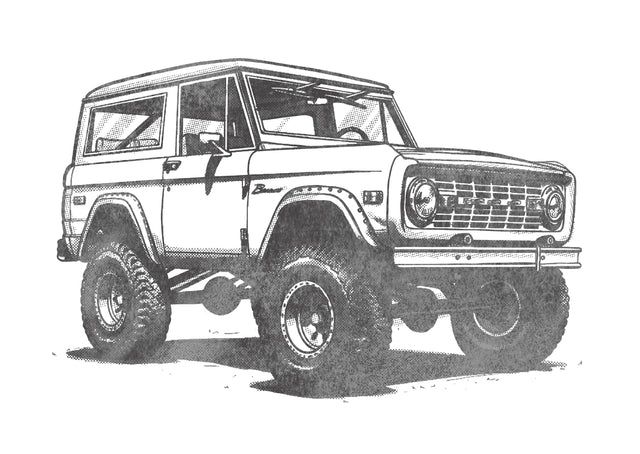The Ford Bronco, an icon in the world of off-road vehicles, has a rich history dating back to its earliest models that have inspired generations of adventure seekers and outdoor enthusiasts. With its distinctive design, rugged capability, and a legacy that spans over half a century, the Bronco has left an indelible mark on automotive history.
Origins and Inspiration:
The story of the Ford Bronco began in the early 1960s, when Ford recognized a growing demand for compact, versatile off-road vehicles. Inspired by the success of the International Harvester Scout and the Jeep CJ series, Ford aimed to create a vehicle that could combine the utility of a truck with the agility of an off-road machine. The result was the first-generation Ford Bronco, introduced in 1966.
Design and Function:
The design of the original Bronco was characterized by its boxy and compact body, offering a no-nonsense appearance that exuded strength and durability. It featured a removable hardtop, open-air driving capabilities, and a utilitarian interior layout. The short wheelbase and wide stance provided stability and maneuverability both on and off the road.
Underneath its rugged exterior, the Bronco boasted a robust drivetrain and suspension system that set it apart from its competitors. The earliest models came equipped with a solid front axle, coil springs, and a rear leaf-spring suspension, allowing the Bronco to handle rough terrains with ease. This combination of components contributed to its exceptional off-road prowess, making it a favorite among outdoor enthusiasts and weekend adventurers.
Consumer Reception and Lifestyle Influence:
Upon its debut, the Ford Bronco garnered immediate attention and enthusiasm from consumers. Its versatility and capability made it an appealing choice for a wide range of uses, from ranch work to recreational outings. The Bronco quickly became a symbol of freedom, embodying the spirit of exploration and outdoor adventure.
As the Bronco gained popularity, it inspired a variety of lifestyle choices and activities. Camping, hunting, fishing, and exploring remote trails became synonymous with the Bronco experience. It encouraged a sense of community among enthusiasts who shared a passion for off-road adventures and embraced a rugged, back-to-basics lifestyle.
Innovations and Drivetrain Evolution:
Over the years, the Ford Bronco underwent significant innovations and changes to its drivetrain to keep up with evolving technologies and consumer demands. In 1973, the second-generation Bronco was introduced, featuring improved suspension components, more powerful engines, and the availability of automatic transmissions. This iteration further cemented the Bronco's reputation as a capable and versatile off-road vehicle.
In 1980, Ford introduced the third-generation Bronco, which marked a departure from the compact design of its predecessors. This model featured a larger and more luxurious body, catering to a wider audience that sought both on-road comfort and off-road capability. The introduction of four-wheel drive (4WD) systems with shift-on-the-fly capability and improved suspension designs further enhanced the Bronco's performance across various terrains.
Engine Evolution and Iterations:
Throughout its storied history, the Ford Bronco experienced a diverse range of engine options that evolved alongside changing consumer preferences and technological advancements. The earliest models, launched in 1966, were equipped with a 170-cubic-inch inline-six engine, providing a balance of efficiency and power for off-road adventures.
As the Bronco gained popularity, its engine offerings expanded. The second-generation Bronco, introduced in 1973, saw the introduction of a more potent 302-cubic-inch V8 engine, catering to those seeking increased performance. This engine upgrade complemented the vehicle's rugged persona and contributed to its growing reputation as a formidable off-road machine.
In subsequent years, the Bronco continued to offer various engine choices, including inline-six and V8 options, each tuned for improved power and efficiency. With the third-generation Bronco's arrival in 1980, a wider range of engine sizes became available, catering to diverse driving needs. These engines were often paired with advancements in transmission technology, such as automatic transmissions, which further enhanced the Bronco's versatility and ease of use.
Major Design Changes and Modern Revival:
As the years passed, the Bronco continued to evolve in response to changing market trends and consumer preferences. In 1996, Ford decided to discontinue the Bronco, marking the end of an era for the beloved off-roader.
However, the Bronco's legacy refused to fade away. In 2020, Ford announced the return of the Bronco with an all-new, fourth-generation model. The modern Bronco retained the rugged and distinctive design elements of its predecessors while incorporating advanced technologies, enhanced safety features, and a range of engine options, including eco-friendly alternatives. This revival was met with immense anticipation and excitement from fans and enthusiasts worldwide.
Conclusion:
The Ford Bronco's history is a testament to its enduring appeal and influence on automotive culture. From its humble beginnings as a utilitarian off-roader inspired by iconic predecessors, to its modern-day revival as a technologically advanced adventure vehicle, the Bronco's journey through time reflects its ability to capture the hearts of generations. Its impact extends beyond the realm of automobiles, shaping lifestyles, inspiring outdoor exploration, and creating a sense of camaraderie among enthusiasts who share a passion for exploration and freedom. As the Bronco continues to forge ahead into new horizons, its legacy as an enduring symbol of ruggedness and adventure remains firmly intact.
Engine Evolution and Iterations:
Throughout its storied history, the Ford Bronco experienced a diverse range of engine options that evolved alongside changing consumer preferences and technological advancements. The earliest models, launched in 1966, were equipped with a 170-cubic-inch inline-six engine, providing a balance of efficiency and power for off-road adventures.
As the Bronco gained popularity, its engine offerings expanded. The second-generation Bronco, introduced in 1973, saw the introduction of a more potent 302-cubic-inch V8 engine, catering to those seeking increased performance. This engine upgrade complemented the vehicle's rugged persona and contributed to its growing reputation as a formidable off-road machine.
In subsequent years, the Bronco continued to offer various engine choices, including inline-six and V8 options, each tuned for improved power and efficiency. With the third-generation Bronco's arrival in 1980, a wider range of engine sizes became available, catering to diverse driving needs. These engines were often paired with advancements in transmission technology, such as automatic transmissions, which further enhanced the Bronco's versatility and ease of use.

